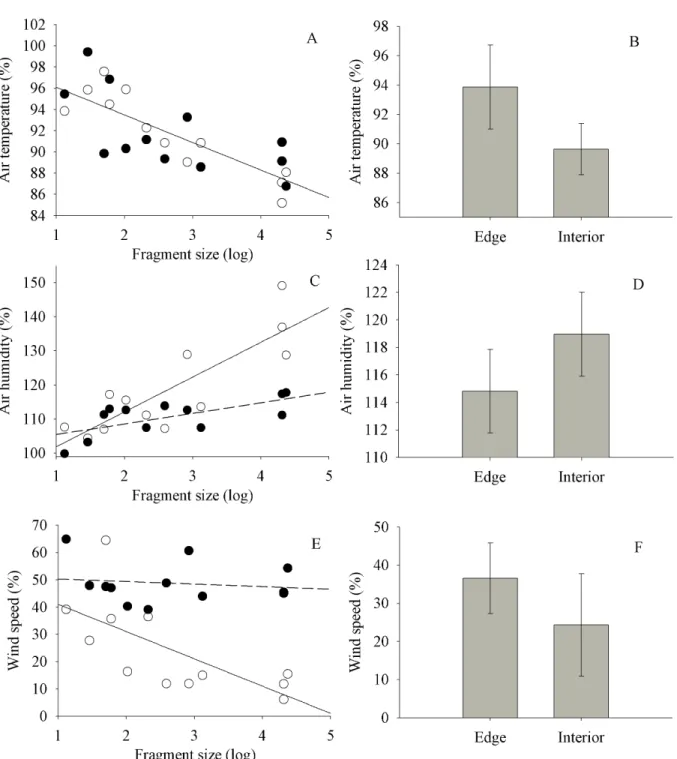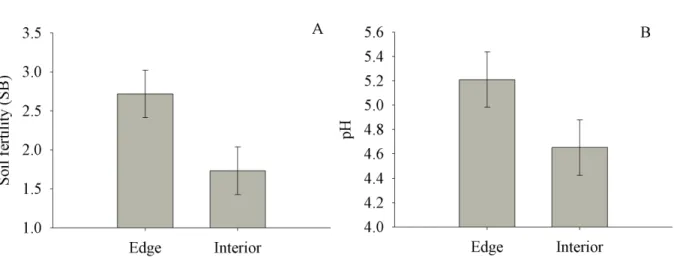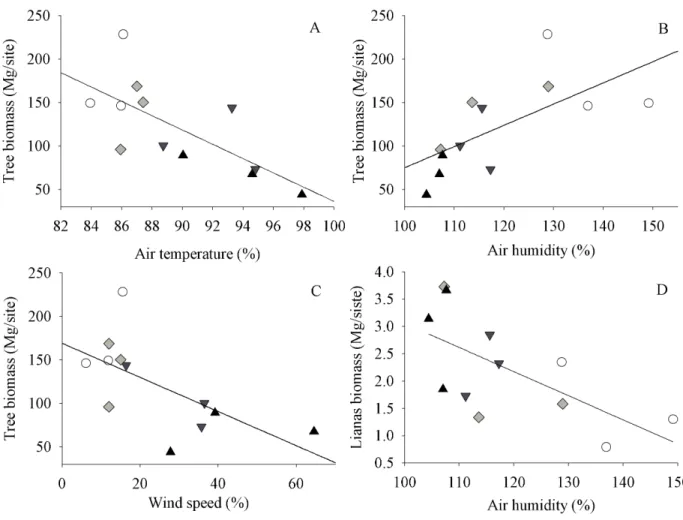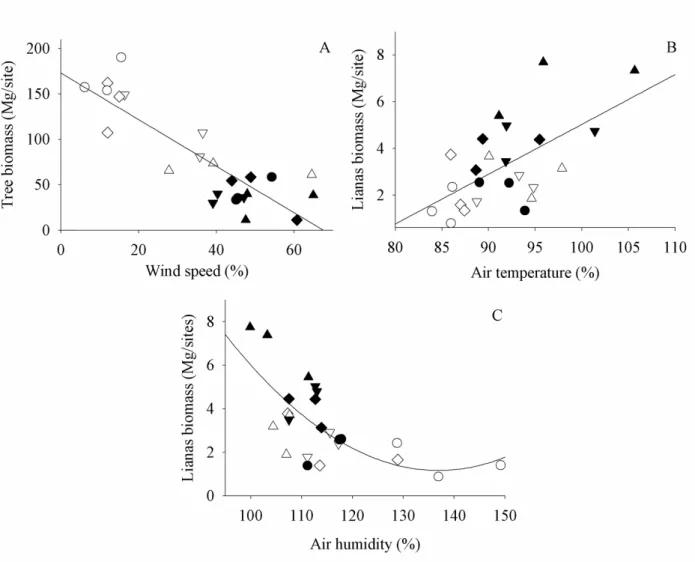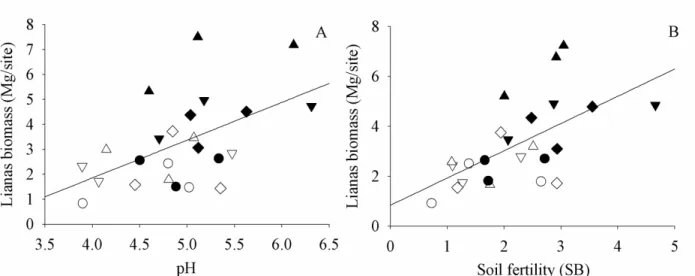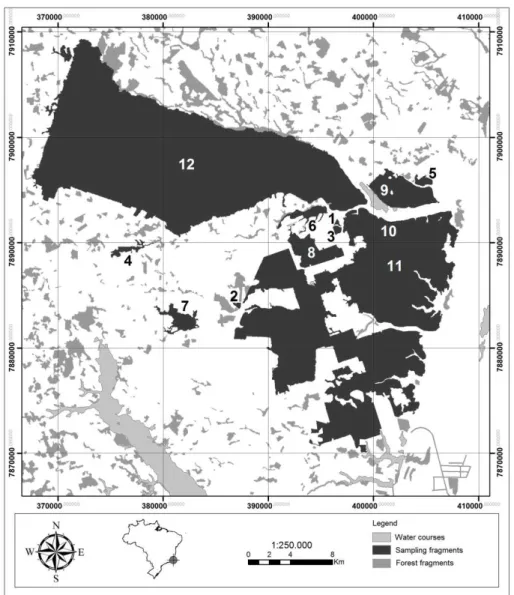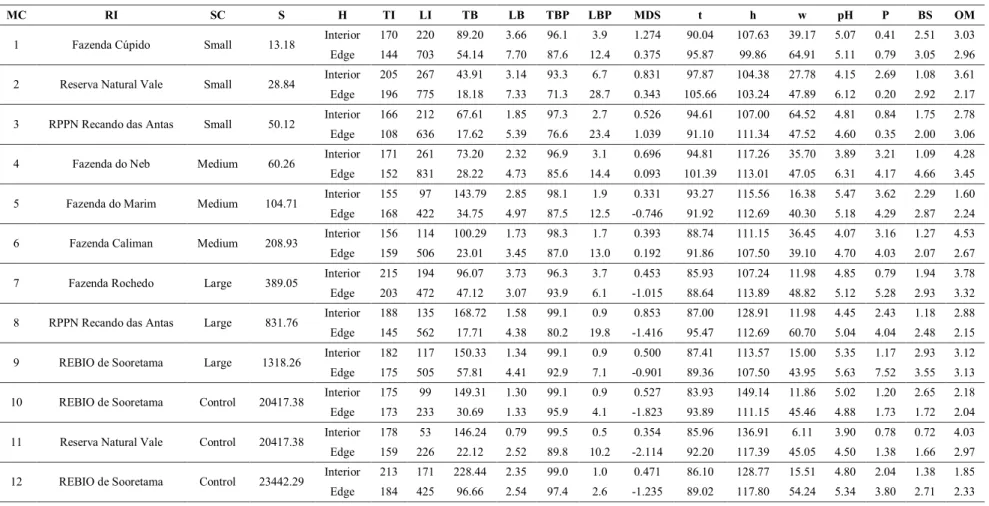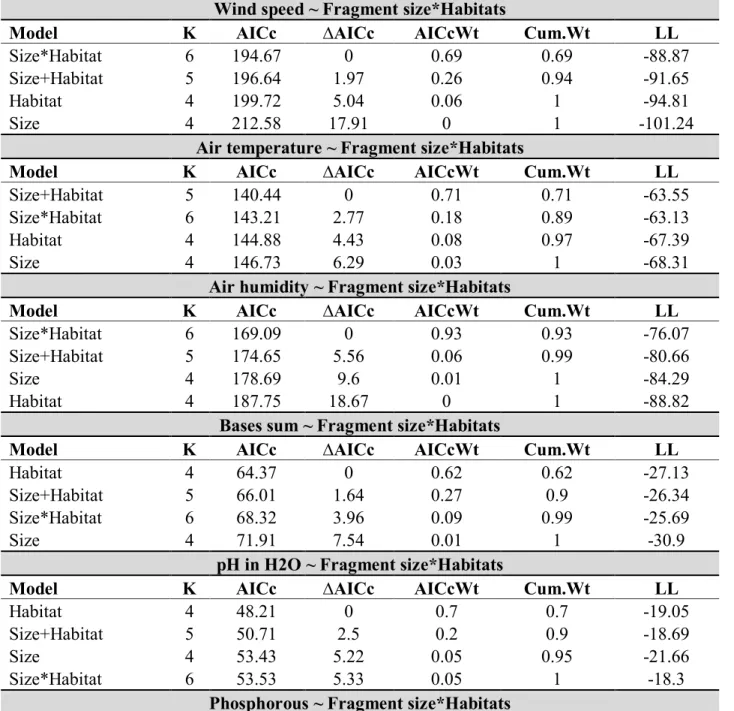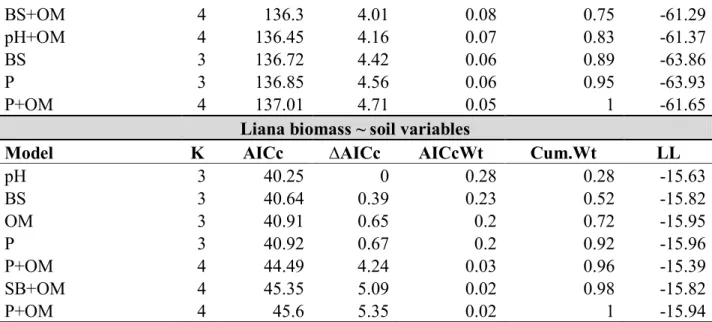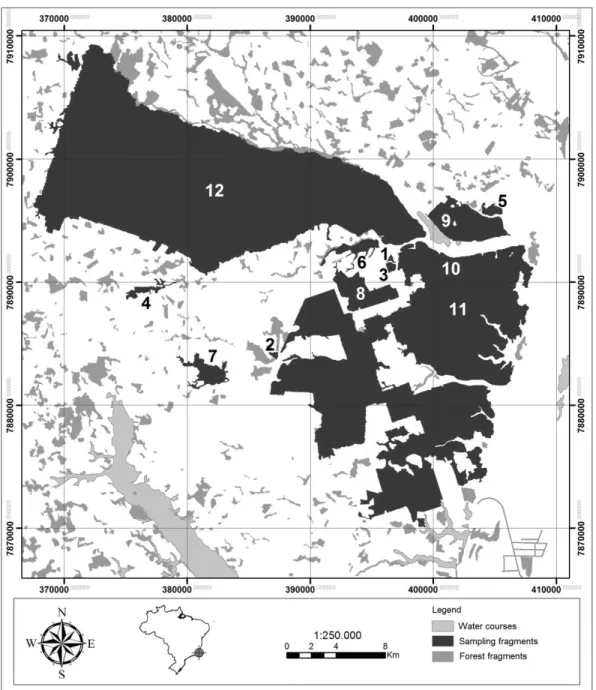LUIZ FERNANDO SILVA MAGNAGO
FOREST FRAGMENTATION ON TREE COMMUNITIES, FUNCTIONAL DIVERSITY
AND CARBON STORAGE IN A BRAZILIAN ATLANTIC RAIN FOREST
Tese apresentada à Universidade Federal de Viçosa, como parte das exigências do Programa de Pós-Graduação em Botânica, para obtenção do título de
Doctor Scientiae.
VIÇOSA
Ficha catalográfica preparada pela Seção de Catalogação e Classificação da Biblioteca Central da UFV
T
Magnago, Luiz Fernando Silva, 1983-
M196f Forest fragmentation on tree communities, functional 2013 diversity and carbon storage in a Brazilian Atlantic Rain
Forest / Luiz Fernando Silva Magnago. Viçosa, MG, 2013. xiii, 124 f. : il. ; 29 cm.
Texto em inglês e português.
Orientador: Sebastião Venâncio Martins.
Tese (doutorado) - Universidade Federal de Viçosa. Inclui bibliografia.
1. Ecologia vegetal. 2. Biologia de conservação. 3. Comunidades vegetais. 4. Ecossistemas. 5. Sequestro de carbono. 6. Ecossistemas em extinção. I. Universidade Federal de Viçosa. Departamento de Biologia Vegetal. Programa de Pós-Graduação em Botânica. II. Título.
LUIZ FERNANDO SILVA MAGNAGO
FOREST FRAGMENTATION ON TREE COMMUNITIES, FUNCTIONAL DIVERSITY
AND CARBON STORAGE IN A BRAZILIAN ATLANTIC RAIN FOREST
Tese apresentada à Universidade Federal de Viçosa, como parte das exigências do Programa de Pós-Graduação em Botânica, para obtenção do título de
Doctor Scientiae.
AGRADECIMENTOS
Primeiramente a DEUS, por me fornecer toda força necessária para realizar todas as
tarefas que me foram designadas e também por me proporcionar belos momentos, os quais eu
vou procurar aproveitar o máximo.
Aos meus pais, Laerte e Denise, e meu irmão Luiz Claudio por todo o suporte, amor e
carinho durante a minha vida.
A minha querida eterna namorada Mariana Rocha, meu principal pilar durante toda
minha caminhada, seu amor por mim foi minha benção e sem a sua participação na minha vida
eu não teria chegado até aqui. Te amo de mais e reafirmando o que escrevi nos agradecimentos
da minha dissertação de mestrado em 2009 e permaneço esperando passar o resto da minha com
você. Te amo.
A toda minha família, que sempre estiveram ao meu lado com muito carinho.
A Universidade Federal de Viçosa, em principal ao departamento de Biologia Vegetal,
que me aceitou na universidade. Em especial ao Ângelo, por todo suporte, amizade e auxilio, os
quais foram imprescindíveis para minha adequação aos procedimentos da UFV.
A CAPES (Coordenação de Aperfeiçoamento de Pessoal de Nível Superior) pela
conceição da minha bolsa de Doutorado e a de Doutorado Sanduíche. Ao CNPQ pelo auxílio
financeiro do meu projeto de tese. A Reserva Natural Vale pelo apoio logístico e alimentício ao
projeto. A FIBRIA Celulose, pela liberação de estudos em suas reservas. Ao ICMBio pela
liberação dos estudos na REBIO de Sooretama. Ao projeto Pro-Tapir e Instituto Marcos Daniel
que deu apoio logístico para o projeto.
A James Coock University, via Centre for Tropical Environmental & Sustainability
Science, que me aceitou para fazer o doutorado sanduíche sob a supervisão do professor William
F. Laurance (Bill).
Ao meu ilustríssimo orientador, Prof. Sebastião Venâncio Martins, que me aceitou
prontamente assim que eu conversei com ele, me proporcionando todo subsidio para
desenvolvimento desta e de outras pesquisas que realizamos juntos. Agradeço pela sua amizade e
compreensão, bem como por seu incansável incentivo.
Aos meus co-orientadores e amigos da Austrália, Bill Laurance, Dave Edwards e Ainhoa
escrita dos artigos e também por sua amizade e compreensão, onde sem os quais este trabalho
não seria o mesmo e minha estadia na Australia não seria a mesma.
Aos amigos brasileiros Leo, Mari, Fernanda, Jean e Ana que tornaram minha estádia na
Austrália ainda mais rica e prazerosa. Em especial a Mari e o Leo que foram amigos de verdade,
me ajudando como tudo que foi possivel de para que eu conseguisse me encaixar no estilo de
vida Australiano. Muito obrigado mesmo e parabéns pelo Joshua, que foi certamente o maior
presente de vocês. Ao meu amigo "irmão" Jean Loureiro por todo seu incentivo e ajuda na minha
chegada. Aos amigos que fiz na Austrália: Felicity Ansell Edwards, Soan Sloan, Oscar e
Michelli Venter, Susan Laurance, Mason Campbell, Breat, Meric, Daniele, Jane, Miriam
Goosem, Cristien, Damien, Annu, Eric Katovai. Muito Obrigado mesmo pessoal.
Um agradecimento especial aos fiéis estagiários, biólogos e amigos colaboradores do
trabalho de campo. Mariana Rocha, Marcelo Simonelli, Glaucia Tolentino, Renata Pagotto,
Vinicius Guss, Stephano, Túlio, Átila, André M. de Assis, Geana Correia, Fabio Matos,
Herivelton Borges (Beri), Oberdan J. Pereira.
Ao pessoal do departamento de Biologia Vegetal da Universidade Federal do Espírito
Santo, em especial para Stephan e Luciana Dias Thomaz, pela permissão para uso do Herbário.
A FAESA, em especial ao Prof. Marcelo Simonelli e João Barra por permitir e ajudar no
uso do laboratório de taxonomia para processamento do material pedológico.
Aos grandes amigos Marcelo Simonelli, Oberdan J. Pereira e André M. de Assis ilustres
Botânicos do Espírito Santo. Agradeço a todos vocês por todo apoio e grande amizade ao longo
deste caminho nesta ciência, sempre me ensinando sem poupar esforços.
Aos caros taxonomistas que prontamente me ajudaram na determinação do material
coletado. André Amorim (Malpighiaceae), Marcos Sobral e Marcelo Costa (Myrtaceae), Luis
Claudio Fabris (Sapotaceae) e Pedro Luís Rodrigues de Moraes (Lauraceae). Aos fitossociólogos
Oberdan J. Pereira, André M. de Assis e José Manoel L. Gomes pela ajuda geral na determinação
das espécies.
Aos grandes amigos de república Fabio Matos, Rennan Stein, Rodrigo, Leandro, Ricardo
e Vinicius. Em especial a dois capixabas que são meus irmãos Fabio Matos e Thiago Coser.
Vocês realmente fizeram e fazem diferença na minha vida e sei que essa amizade irá durar por
Aos caros amigos da pós de graduação em botânica em especial a Dayana, Jaquelina,
Rubia, Alice, Virginia, Saporetti, Pryscila, Gláucia, Carol, Vitor, entre muitos outros que
tornaram Viçosa um lugar mais caloroso.
Aqueles que por ventura não estão com seu nome por extenso neste texto não foram
BIOGRAFIA
LUIZ FERNANDO SILVA MAGNAGO, filho de Laerte José Magnago e Denise Silva
Magnago, irmão de Luiz Claudio Magnago, nasceu em 25 de setembro de 1983, em Vitória,
Espírito Santo.
Fez aulas de músicas com professores particulares, com ênfase em violão popular entre
os anos de 1996 a 1999, passando para guitarra elétrica clássica em 1998 a 2001.
Em dezembro de 2001, concluiu o ensino médio no colégio Darwin: a evolução do
ensino.
Em julho de 2005, graduou-se em Ciências Biológicas na Faculdade de Saúde e Meio
Ambiente - FAESA.
Em março de 2007, ingressou no curso de Mestrado em Botânica, na área de
concentração de Ecologia, com ênfase em Estrutura, Funcionamento e Manejo de Comunidades
Vegetais, na Universidade Federal de Viçosa, Minas Gerais, Brasil, finalizando em Janeiro 2009.
SUMÁRIO
RESUMO ... x
ABSTRACT ... xii
I. Introdução Geral ... 1
II. Referências Bibliográficas ... 5
III. CAPÍTULO I ... 9
FOREST FRAGMENTATION EFFECTS DECREASE TREE BIOMASS AND INCREASE LIANA BIOMASS... 9
ABSTRACT ... 9
Introduction ... 10
Material and Methods ... 11
Study area ... 11
Tree sampling ... 11
Tree and liana biomass estimation ... 12
Microclimatic variables and soil sampling ... 13
Data Analysis ... 14
Results ... 15
Abiotic changes by fragmentation effects ... 15
Microclimate changes impacting forestry biomass ... 17
Discussion... 20
Abiotic changes in fragmented tropical forest fragments ... 20
Biomass changes due to fragmentation effects... 22
References ... 24
SUPPLEMENTARY MATERIAL... 29
IV. CAPÍTULO II ... 36
COMMUNITY AND FUNCTIONAL IMPACTS OF FRAGMENTATION EFFECTS ON TREES SPECIES ... 36
ABSTRACT ... 36
Material and Methods ... 39
Study area ... 39
Tree sampling ... 40
Functional trait matrix ... 41
DataAnalysis ... 42
Results ... 43
Fragments retain important biodiversity value ... 43
Fragmentation, edge effects and tree functional diversity ... 45
Discussion... 48
Fragments and edges effects on biodiversity value ... 48
Fragmentation, edge effects and tree functional diversity ... 49
Implications for conservation and conclusions ... 51
References ... 52
SUPPLEMENTARY MATERIAL... 60
V. CAPÍTULO III ... 80
CAN REDD+ PROVIDE CARBON AND BIODIVERSITY CO-BENEFITS IN A FRAGMENTED TROPICAL FOREST LANDSCAPE? ... 80
ABSTRACT ... 80
Introduction ... 81
Construction and assumptions of models ... 83
Material and Methods ... 84
Studyarea ... 84
Tree sampling ... 84
DataAnalysis ... 86
Results ... 87
How much carbon is in the intact forest? ... 87
What is the impact of fragmentation on carbon stocks? ... 87
What are the impacts of fragmentation on biodiversity metrics? ... 91
Are there co-benefits between carbon stock and biodiversity? ... 92
Discussion... 93
The impact of fragmentation on biodiversity of conservation concern ... 95
Co-benefits among carbon stock and biodiversity ... 95
Implications for future assessments of carbon and biodiversity co-benefits ... 96
References ... 98
SUPPLEMENTARY MATERIAL... 105
RESUMO
MAGNAGO, Luiz Fernando Silva, D.Sc. Universidade Federal de Viçosa, março de 2013. A fragmentação florestal em comunidades arbóreas, diversidade funcional e estoque de carbono na Floresta Atlântica Ombrófila no Brasil. Orientador: Sebastião Venâncio Martins. Co-orientadores: William F. Laurance e Ainhoa Magrach.
A fragmentação das florestas tropicais é uma das maiores ameaças à biodiversidade global, uma
vez que os efeitos após a fragmentação promovem alterações no meio abiótico e com
consequências no meio biótico. Entre os efeitos abióticos estão o aumento dos distúrbios
causados pelo vento e a dessecação microclimática e entre os efeitos bióticos podemos citar o
aumento das taxas de mortalidade, mudanças na composição, estrutura e traços funcionais das
espécies. Para investigar os efeitos da fragmentação na Floresta Atlântica focamos nas espécies
arbóreas, tendo três objetivos gerais: (i) verificar os impactos da fragmentação nas mudanças
abióticas (microclima e atributos do solo) na biomassa florestal acima do solo; (ii) verificar os
impactos da fragmentação na riqueza, estrutura da comunidade e diversidade funcional de
espécies arbóreas; e (iii) verificar a existência de co-benefícios entre biodiversidade e estoque de
carbono para aplicação de mecanismos de conservação por meio do mercado de carbono
(Reducing Emissions from Deforestation and Forest Degradation - REDD+). Nosso experimento
foi desenvolvido em uma paisagem de floresta tropical brasileira conhecida como Florestas de
Tabuleiro, onde o conhecimento sobre a fragmentação florestal ainda é incipiente. Amostramos
12 fragmentos de diferentes tamanhos (3 repetições/tamanho do fragmento) com 240 parcelas de
10mx10m, igualmente distribuídas entre borda e interior e entre quatro classes de tamanho de
fragmentos, sendo pequenos, médios, grandes e controles. Em cada parcela nós coletamos dados
sobre a riqueza de espécies arbóreas, estoque de biomassa acima do solo, estoque de carbono
(estoque de carbono=biomassa/2), cipós e árvores mortas em pé, bem como dados sobre o
microclima e atributos do solo. Nós classificamos as espécies quanto as suas características
funcionais, endêmicas da Floresta Atlântica e ameaçadas de extinção (Lista Vermelha da IUCN).
Os gradientes de dessecação (menores valores de umidade do ar e maiores valores de
temperatura do ar) e aumento da velocidade do vento foram significativos e positivamente
relacionados com a redução de tamanho do fragmento e com a criação de bordas, além disso, o
habitat de borda apresentou um solo mais fértil e menos ácido. Os resultados também mostraram
em habitats de borda e pequenos fragmentos, estando estes relacionados ás mudanças no
microclima e no solo, o que indicou distúrbios na biomassa florestal. O habitat bordas promoveu
mudanças marcantes na estrutura da comunidade de árvores e em suas características funcionais,
reduzindo significativamente a riqueza de espécies e a diversidade funcional, de maneira tal que,
os fragmentos maiores e o habitat de interior das florestas possuem maior potencial de fornecer
recursos alimentares e interações com a fauna. Encontramos uma forte existência de
co-benefícios entre a conservação da biodiversidade e estoque de carbono na paisagem fragmentada
de floresta tropical. Além disso, esta relação de co-benefícios aumenta com o tamanho do
fragmento, onde existe, significativamente, um maior estoque de carbono e significativamente
mais espécies com elevado valor de conservação. Finalizando, temos conclusões notáveis sobre a
fragmentação Florestas Tropicais do Brasil, sendo: (i) as mudanças no microclima e solo são
afetadas pela fragmentação, promovendo um impacto negativo sobre a biomassa de espécies
arbóreas e aumento da biomassa de lianas; (ii) em uma paisagem fragmentada a funcionalidade
ecológica de espécies arbóreas existente em fragmentos maiores foram significativamente
diferentes daquela existente em fragmentos pequenos; e (iii) o mecanismo REDD+ de
co-benefícios pode ser utilizado em uma paisagem fragmentada, mesmo com um nível de
fragmentação elevado, o que sugere que os fundos de REDD+ podem ser utilizados para
beneficiar o estoque de carbono e o valor biológico dos fragmentos através de planos de manejo.
No entanto, pequenos fragmentos têm um papel importante na manutenção dos serviços
ecológicos, tornando-os indispensáveis para a conservação da biodiversidade, principalmente em
um domínio fitogeográfico tão ameaçado quanto o da Floresta Atlântica.
ABSTRACT
MAGNAGO, Luiz Fernando Silva, D.Sc. Universidade Federal de Viçosa, march, 2013. Forest fragmentation on tree communities, functional diversity and carbon storage in a Brazilian Atlantic Rain Forest. Adviser: Sebastião Venâncio Martins. Co-advisers: William F. Laurance and Ainhoa Magrach.
The fragmentation of tropical forests is one of the greatest threats to global biodiversity,
promoting both abiotic and biotic changes. Among the abiotic effects are the increased
disturbance caused by wind and microclimatic desiccation whilst among the biotic effects there
are increases in mortality rates, changes to species composition, forest structure and functional
traits of the species. To investigate the effects of fragmentation in the Atlantic Forest we focus
on tree species, with three main objectives: (i) to verify the impacts of fragmentation on the
abiotic environment (microclimate and soil attributes) and on above ground forest biomass; (ii)
to assess the impacts of fragmentation on richness, community structure and functional diversity
of tree species; and (iii) to evaluate the existence of co-benefits between biodiversity and carbon
stocks in order to implement conservation mechanisms through the carbon market (Reducing
Emissions from Deforestation and Forest Degradation - REDD +). We conducted our
experiments in a Brazilian Tableland Forest fragmented landscape , where the knowledge about
forest fragmentation is still incipient. We sampled 12 fragments of different sizes (3
replicates/fragment size) with 240 10mx10m plots, equally distributed between edge and interior
areas and in each of four fragment size classes: small (≤50 ha), medium (51-250 ha), large
(250-1,500 ha) and control (≥10,000 ha). Inside each plot we recorded tree species richness, above
ground biomass , carbon stocks (carbon stock=biomass/2), liana abundance and abundance of
standing dead trees jointly with microclimate and soil attributes measurements . We also
classified the species in relation to their functional traits, Atlantic Forest endemic character and
level of threat (IUCN Red List). The gradients of desiccation (less air humidity and more air
temperature) and increases of wind speed were significant and positively related with reductions
in fragment size and edge habitat creation, moreover the edge habitat had more fertile soil and
less acid soils. The results also showed significant reductions of tree biomass and an increase in
lianas biomass in edge habitats and small fragments, following the microclimate and soil
changes in tree community structure and functional traits, significantly reducing species richness
and functional diversity, with larger fragments and forest interiors having more potential to
provide food resources and interactions with fauna. We found that biodiversity and carbon stock
were highly spatially congruent in our study area. Also, these co-benefit relationship increased
with fragment size, where significant increases in carbon stocks are coupled with species of high
conservation value. Finally our results lead us to the following noteworthy conclusions about
Brazilian Rainforest fragmentation: (i) microclimate and soil changes driven by fragmentation
promoted negative impacts on tree biomass and an increase in liana biomass; (ii) in a fragmented
landscape plant functionality of larger fragments was significantly different to that of smaller
fragments; (iii) the REDD+ co-benefits can be used in fragmented landscape, even subjected to
high fragmentation levels, suggesting that additional REDD+ funds could be used to enhance the
carbon and biological value through the management of fragmented landscapes. Nonetheless,
small fragments have an important role in the maintenance of ecological services making them
I. Introdução Geral
As florestas tropicais são reconhecidas como o mais importante repositório da
biodiversidade mundial (Ayres et al. 2005). Cobrindo apenas 7% da superfície terrestre, abrigam mais da metade das espécies biológicas do planeta (Myers 1997), sendo a maioria
completamente desconhecida pela ciência. Há estimativas de que mais de 200.000 km2 de
florestas tropicais são destruídas por ano (Myers 1997), o que representa uma inestimável perda
de diversidade biológica, principalmente quando se trata de florestas que ainda permanecem em
seu estado primário (Gibson et al. 2011). Estas florestas têm diferentes funções na regulação
climática, como a de sequestrar e estocar carbono da atmosfera em sua biomassa, tendo assim,
significativas influências na regulação climática, que vão desde escalas locais até mundiais
(Laurance 2004; Laurance et al. 2011).
A fragmentação das florestas tropicais é citada como uma das principais ameaças a
biodiversidade de espécies e à funcionalidade ecológica dos ecossistemas (Pardini et al. 2010;
Gibbs et al. 2010; Pütz et al. 2011). O processo de desmatamento, que transforma uma paisagem
de florestas contínuas em uma paisagem de mosaicos de fragmentos florestais de diferentes
tamanhos e geralmente imersos em matrizes antrópicas diferenciadas (Bennett & Saunders
2010), atua primeiramente na destruição do habitat, acarretando em uma perda imediata de
espécies, de funcionalidade ecológica e da biomassa estocada. Posteriormente ao processo de
fragmentação per se (veja Fahrig 2003), os efeitos de bordas trazem mais perdas de biodiversidade e biomassa, devido às alterações no meio abiótico (promovidos pelo vento,
dessecação e mudanças na ciclagem de nutrientes), sendo estas seguidas por mudanças no meio
biótico, como o aumento das taxas de mortalidade e proliferação de espécies tolerantes a
luminosidade nos fragmentos remanescentes (Laurance et al. 2006; Haper et al. 2005; Pütz et al.
2011).
Estudar as alterações na riqueza e composição de espécies em função dos efeitos da
criação de bordas e/ou da redução dos tamanhos dos fragmentos remanescentes têm sido um dos
temas mais importantes em estudos sobre a fragmentação em florestas tropicais (Laurance et al.
2002; Tabarelli et al. 2010; Pardini et al. 2010; Pütz et al. 2011). Nesse contexto, a maior parte
dos estudos com biodiversidade foi baseada na identidade taxonômica das espécies, revelando
muito utilizados para indicar áreas com relevante importância para conservação (e.g. Myers
1988; Hill et al. 2003; Edwards et al. 2011). No entanto, as informações baseadas na identidade
taxonômica muitas vezes mostram-se incompletas para demonstrar as mudanças na
biodiversidade em relação ao ambiente, pois eles não levam em conta a identidade biológica e as
diferenças funcionais entre as espécies, sendo muitas vezes insuficientes por si só para explicar
os processos ecossistêmicos (Villéger et al. 2010). Como o estudo da fragmentação pode ser
muito complexo, pois lida com um variedade imensa de variáveis ambientais, advindas das
mudanças microclimáticas, no solo, na dinâmica florestal, do histórico de uso da paisagem e das
interações biológicas (Murcia et al. 1995; Laurance et al. 2002; Fahrig 2003; Harper et al. 2005),
o uso de metodologias que podem nos ajudar a reconhecer o papel funcional das espécies no
ambiente é imprescindível (Chapin 2003).
Desta forma, as análises de diversidade funcional tem sido utilizadas em artigos recentes
para determinar as respostas das funções ecossistêmicas das assembléias de espécies as
mudanças ambientais (Cadotte et al. 2011), tendo mostrado resultados interessantes na descrição
de distúrbios ambientais na funcionalidade ecossistêmica (Villéger,et al. 2010; Pakeman et al.
2011; Baraloto et al. 2012). As respostas obtidas pelas análises com os índices de diversidade
funcional em relação às variações no ambiente tem sido mais expressivas que a dos os índices
que descrevem a diversidade de espécies (Loreau et al. 2001), isso devido as diferenças na
funcionalidade atribuídas a cada espécie (Petchey & Gaston 2002), o que determina qual a
função de uma dada espécie dentro da comunidade.
As florestas tropicais mantêm uma alta produção de biomassa acima do solo pela
vegetação, podendo contribuir para até um terço da produtividade primária líquida dos
ecossistemas terrestres (Field et al. 1998), tendo assim uma importância ecológica
imprescindível para manter o ciclo de carbono do planeta (Keeling & Phillips, 2007). Entretanto,
a elevada taxa de desmatamento das florestas tropicas (veja Gibbs et al. 2010), libera esse grande
estoque de carbono contido na biomassa na forma de gases estufa para atmosfera (Laurance
2006), trazendo consequências negativas e provavelmente irreversíveis para o clima do planeta
(Solomon et al. 2009).
Desta forma, estudos que visam investigar como os impactos da fragmentação atuam na
perda de biomassa são de suma importância, visto que biomassa florestal é considerada uma
eficiência do armazenamento de carbono na matéria orgânica reflete a qualidade das condições
ambientais existente em fragmentos remanescentes, tais como o clima e os atributos do solo
(Chave et al. 2001).
Com objetivo de minimizar os efeitos dos gases estufa nas mudanças climáticas o
mecanismo REDD (Reduced Emissions from Deforestation and Degradation) propõe que os países inseridos nas florestas tropicais seriam compensados por reduzirem suas taxas de
desmatamento, e assim diminuir as emissões de gases de efeito estufa (Grainger et al. 2009). O
mecanismo REDD evoluiu e passou a ter em seu escopo, a conservação de biodiversidade por
meio da proteção do estoque de carbono (co-benefícios), sendo então designado como REDD+
(Grainger et al. 2009). Desta forma, a integração desses co-benefícios é atualmente o centro dos
esforços das ações conservacionistas mundiais (Phelps et al. 2012).
Por ser um tema relativamente recente, essa relação de co-benefícios ainda carece de
comprovação empírica, impossibilitando a aplicação confiável dos conceitos do REDD+ para
conservação da biodiversidade por meio da proteção de florestas com potencial estoque de
carbono (UNEP-WCMC 2008; Diaz et al. 2009; Talbot 2010; Phelps et al. 2012). Isto tem
resultado na aplicação desse mecanismo com benefícios apenas para áreas com interesse para o
estoque de carbono e não para a biodiversidade (Lindenmayer et al. 2012).
Quando pensamos em investigar a viabilidade teórica dos co-benefícios em paisagens
fragmentadas, temos que considerar indubitavelmente, a importância dos efeitos ecológicos da
fragmentação, associados principalmente à redução no tamanho dos fragmentos remanescentes e
à criação do habitat de borda, já que a maior parte dos remanescentes florestais tropicais está
impactada pelos efeitos do desmatamento (Gibbs et al. 2010).
Entre os ecossistemas mundiais que são considerados prioritários para conservação da
biodiversidade está o hotspot de Floresta Atlântica (Myers et al. 2000). Quando pensamos na Floresta Atlântica brasileira as primeiras coisas que lembramos são: a elevada riqueza de
espécies que se pode encontrar e o quão deflorestado está esse domínio fitogeográfico. Não é
para menos que pensemos assim, pois na Floresta Atlântica é possível encontrar mais de 380
espécies arbóreas em apenas um hectare de floresta (Saiter et al. 2011), e devido ao
deflorestamento toda essa riqueza de espécies está confinada a apenas 11.26% de cobertura
florestal remanescente, com 80% dos fragmentos menores que 50 hectares (Ribeiro et al. 2009).
ponto de impactar severamente a riqueza de espécies existentes nos fragmentos remanescentes
(e.g. Pardini et al. 2010).
Contudo, na Floresta Atlântica, principalmente nos trechos mais próximos ao litoral,
ainda existem paisagens florestais fragmentadas que podem apresentar uma biodiversidade de
relativo valor para conservação (espécies ameaçadas de extinção e endêmicas) e ainda um
elevado potencial para estocar carbono na biomassa vegetal (veja Rolim et al. 2005),
configurando um elevado potencial para aplicações de mecanismos conservacionistas, e.g.
REDD+ (Strassburg et al. 2010).
Focamos o nosso estudo na biodiversidade de espécies arbóreas, na funcionalidade
ecológica existente nos fragmentos, na biomassa acima do solo e no estoque de carbono em uma
paisagem de Floresta Atlântica, tendo como objetivos gerais: (i) verificar os impactos da
fragmentação nas mudanças abióticas (microclima e atributos do solo) e na biomassa florestal
acima do solo; (ii) verificar os impactos da fragmentação na riqueza e estrutura da comunidade
de espécies arbóreas, bem como nas mudanças dos traços e diversidade funcional; e (iii) avaliar a
existência de co-benefícios entre biodiversidade e estoque de carbono para aplicação de
mecanismos de conservação por meio do mercado de carbono (REDD+).
Para isso selecionamos uma paisagem fragmentada de Floresta Atlântica de Tabuleiro no
norte do Espírito Santo, Sudeste do Brasil. Essa paisagem apresenta uma elevada relevância para
conservação devido à presença de dois fragmentos com tamanho acima dos 20.000 hectares, que
representam apenas 0.08% dos remanescentes florestais existentes nesse bioma no Brasil
(Ribeiro et al. 2009). As Florestas de Tabuleiro estudadas ainda são reconhecidamente detentoras
de uma elevada diversidade de espécies vegetais e animais (Peixoto & Silva 1997; Chiarello et
al. 1999; Masden et al. 2001).
Para melhor compreensão e atendimento dos objetivos propostos, a presente tese de
doutorado foi dividida em três capítulos. Desta forma, cada capítulo traz em detalhes as
II. Referências Bibliográficas
Ayres, J. M.; Fonseca, G. B.; Rylands, A. B. Queiroz, H. L. Pinto, L. P. Masterson, D. &
Cavalcanti, R. B. 2005. Os Corredores Ecológicos das Florestas Tropicais do Brasil.
Sociedade Civil Mamirauá, Rio de Janeiro.
Baraloto, C.; Hérault, B.; Timothy, C. E. T.; Massot, H.; Blanc, L.; Bonal, D.; Molino, J-F.;
Nicolini, E. A.; Sabatier, D. 2012. Contrasting taxonomic and functional responses of a
tropical tree community to selective logging. Journal of Applied Ecology 1365-2664.
Bennett, A. F.; Saunders, D. A. 2010. Habitat fragmentation and landscape change. In: Sodhi, N.
& Ehrlich P. (eds.). Conservation Biology for all. pp. 88-106. Oxford University Press:
Oxford.
Cadotte, M. W.; Carscadden, K.; Mirotchnick, N. 2011. Beyond species: functional diversity and
the maintenance of ecological processes and services. Journal of Applied Ecology 48:
1079–1087.
Chapin, F. S. III. 2003. Effects of Plant Traits on Ecosystem and Regional Processes: a
Conceptual Framework for Predicting the Consequences of Global Change. Annals of
Botany 91(4): 455-463.
Chave, J.; Riera, B.; Dubois, M.-A. 2001. Estimation of Biomass in a Neotropical Forest of
French Guiana: Spatial and Temporal Variability. Journal of Tropical Ecology 17(1):
79-96.
Díaz, S.; Hector, A.; Wardle, D. A. 2009. Biodiversity in forest carbon sequestration initiatives:
not just a side benefit. Current Opinion in Environmental Sustainability 1: 55–60.
Edwards, D. P.; Larsen, T. H.; Docherty, Teegan D. S.; Ansell, F. A.; Hsu, W. W.; Derhé, M. A.;
Hamer, K. C.; Wilcove, D. S. 2011. Degraded lands worth protecting: the biological
importance of Southeast Asia’s repeatedly logged forests. Proceedings of the Royal
Society B:278: 82–90.
Fahrig, L. 2003. Effects of habitat fragmentation on biodiversity. Annual Review of Ecology,
Evolution and Systematics 34: 487-515.
Field, C. B.; Behrenfeld, M. J.; Randerson, J. T.; Falkowski, P. 1998. Primary production of the
Gibbs, H. K; Ruesch, A. S.; Achard, F.; Clayton, M. K.; Holmgren, P.; Ramankutty, N.; Foley, J.
A. 2010. Tropical forests were the primary sources of new agricultural land in the 1980s
and 1990s. PNAS 107(38): 16732–16737.
Gibson, L.; Lee, T. M.; Koh, L. P.; Brook, B. W.; Gardner, T. A.; Barlow, J.; Peres, C. A.;
Bradshaw, C. J. A.; Laurance, W. F.; Lovejoy, T. E.; Sodhi, N. S. 2011. Primary forests
are irreplaceable for sustaining tropical biodiversity. Nature 478: 378-381.
Grainger, A.; Boucher, D. H.; Frumhoff, P. C.; Laurance, W. F.; Lovejoy, T.; McNeely, J.;
Niekisch, M.; Raven, P.; Sodhi, N. S.; Venter, O.; Pimm, S. L. 2009. Biodiversity and
REDD at Copenhagen. Current Biology 19(2): 1-3.
Harper, K. A.; MacDonald, S. E.; Burton, P. J.; Chen, J.; Brosofske, K. D.; Saunders, S. C.;
Euskirchen, E. S.; Roberts, D.; Jaiteh, M.S. & Esseen, P. 2005. Edge influence on forest
structure and composition in fragmented landscapes. Conservation Biology 19: 768-782.
Hill, J. L.; Curran, P. J. 2003. Area, shape and isolation of tropical forest fragments: effects on
tree species diversity and implications for conservation. Journal of Biogeography 30:
1391–1403.
Keeling, H. C.; Phillips, O. L. 2007. The global relationship between forest productivity and
biomass. Global Ecology and Biogeography 16: 618 –631.
Laurance, W. F. 2004. Forest-climate interactions in fragmented tropical landscapes.
Philosophical Transactions of the Royal Society B 359: 345–352.
Laurance, W. F.; Camargo, J. L. C.; Luizão, R. C. C.; Laurance, S. G.; Pimm, S. L.; Bruna, E.
M.; Stouffer, P. C.; Williamson, G. B.; Benítez-Malvido, J.; Vasconcelos, H. L.; et al.
2011. The fate of Amazonian forest fragments: A 32-year investigation. Biological
Conservation 144: 56–67.
Laurance, W. F.; Lovejoy, T. E.; Vasconcelos, H. L.; Bruna, E. M.; Didham, R. K.; Stouffer, P.
C.; Gascon, C.; Bierregaard, R. O.; Laurance, S. G.; Sampaio, E. 2002. Ecosystem Decay
of Amazonian Forest Fragments: a 22-Year Investigation.Conservation Biology 16:
605-618.
Laurance, W. F.; Nascimento, H.; Laurance, S. G.; Andrade, A.; Ribeiro, J.; Giraldo, J.; Lovejoy,
T. E.; Condit, R.; Chave, J.; D’Angelo, S. 2006. Rapid decay of tree community
composition in Amazonian forest fragments. Proceedings of the National Academy of
Lindenmayer, D. B.; Hulvey, K. B.; Hobbs, R. J.; Colyvan, M.; Felton, A.; Possingham, H.;
Steffen, W.; Wilson, K.; Youngentob, K.; Gibbons, P. 2012. Avoiding bio-perversity
from carbon sequestration solutions. Conservation Letters 5: 28–36.
Loreau, M. S.; Naeem, P.; Inchausti, J.; Bengtsson, J. P.; Grime, A.; Hector, D. U.; Hooper, M.
A.; Huston, D.; Raffaelli, B.; Schmid, D.; Tilman, D.; Wardle, D. A. 2001. Biodiversity
and ecosystem functioning: current knowledge and future challenges. Science 294: 804–
808.
Marsden, S. J.; Whiffin, M.; Galetti, M. 2001. Bird diversity and abundance in forest fragments
and Eucalyptus plantations around an Atlantic forest reserve, Brazil. Biodiversity and
Conservation 10: 737-751.
Murcia, C. 1995. Edge effects in fragmented forests: implications for conservation. Tree 10:
58-62.
Myers, N. 1988. Threatened biotas: hotspots in tropical forests. The Environmentalist 8: 178–
208.
Myers, N. 1997. Florestas tropicais e suas espécies-sumindo, sumindo...?. In: Wilson, E.O
(ed.). Biodiversidade. Ed. Nova Fronteira, Rio de Janeiro.
Myers, N.; Mittermeier, R. A.; Mittermeier, C. G.; Fonseca, G. A. B.; Kent, J. 2000. Biodiversity
hotspots for conservation priorities. Nature 403: 853-858.
Pakeman, R. J.; Lennon, J. J.; Brooker, R. W. 2011. Trait assembly in plant assemblages and its
modulation by productivity and disturbance. Oecologia 167: 209–218
Pardini, R.; Bueno, A. A.; Gardner, T. A.; Prado, P. I.; Metzger, J. P. 2010. Beyond the
Fragmentation Threshold Hypothesis: Regime Shifts in Biodiversity Across Fragmented
Landscapes. PloS One 5(10): 1-10.
Peixoto, A. L; Silva, I. M. 1997. Tabuleiro Forests of Northern Espirito Santo, Southeastern
Brasil. In: Centres of Plant Diversity - A Guide and Strategy for Their Conservation.
Vol. 3. (Orgs SD Davis, VH Heywood). pp. 369-372. WWF and IUCN Publisher:
Cambridge.
Petchey, O. L.; Gaston, K. J. 2002. Functional diversity (FD), species richness, and community
composition. Ecology Letters 5: 402–411.
Phelps, J.; Webb. E. L.; Adams, W. M. 2012b. Biodiversity co-benefits of policies to reduce
Pütz, S.; Groeneveld, J.; Alves, L. F.; Metzger, J. P.; Huth, A. 2011. Fragmentation drives
tropical forest fragments to early successional states: A modelling study for Brazilian
Atlantic forests. Ecological Modelling 222: 1986-1997.
Ribeiro, M. C.; Metzer, J. P.; Martensen, A. C.; Ponzoni, F.J.; Hirota, M. M. 2009. The Brazilian
Atlantic Forest: How much is left, and how is the remaining forest distributed?
Implications for conservation. Biological Conservation 142: 1141-1153.
Rolim, S. G.; Jesus, R. M.; Nascimento, H. E. M.; Couto, H. T. Z; Chambers, J. Q. 2005.
Biomass change in an Atlantic tropical moist forest: the ENSO effect in permanent
sample plots over 22-year period. Oecologia 142(2): 238 - 246.
Saiter, F. Z.; Guimarães, G. F. A.; Thomaz, L. D.; Wendt, T. 2011. Tree changes in a mature
rainforest with high diversity and endemism on the Brazilian coast. Biodiversity and
Conservation 20: 1921-1949.
Solomon, S.; Plattnerb, G.-K.; Knuttic, R.; Friedlingstein, P. 2009. Irreversible climate change
due to carbon dioxide emissions. PNAS 106(6): 1704-1709.
Strassburg, B. B. N.; Kelly, A.; Balmford, A.; Davies, R. G.; Gibbs, H. K.; Lovett, A.; Miles, L.;
Orme, D.C.D.L.; Price, J.; Turner, R.K.; Rodrigues, A.S.L. 2010. Global congruence of
carbon storage and biodiversity in terrestrial ecosystems. Conservation Letters 3: 98–
105.
Tabarelli, M.; Aguiar, A. V.; Girão, L. C.; Peres, C. A.; Lopes, A. V. 2010. Effects of Pioneer
Tree Species Hyperabundance on Forest Fragments in Northeastern Brazil. Conservation
Biology 24(6): 1654–1663.
Talbot, J. D. 2010. Carbon and biodiversity relationships in tropical forests. Multiple
Benefits Series 4. Prepared on behalf of the UN-REDD Programme. School of
Geography, University of Leeds, Leeds/UNEP World Conservation Monitoring Centre,
Cambridge.
UNEP-WCMC. 2008. Carbon and biodiversity: a demonstration atlas. In: Kapos V.;
Ravilious C.; Campbell A.; Dickson B.; Gibbs H.; Hansen M.; Lysenko I.; Miles L.;
Price J.; Scharlemann J.P.W.; Trumper K (eds.). UNEP-WCMC, Cambridge, UK.
Villéger, S.; Miranda, J. R.; Hernandez, D. F.; Mouillot, D. 2010. Contrasting changes in
taxonomic vs. functional diversity of tropical fish communities after habitat degradation.
III. CAPÍTULO I
FOREST FRAGMENTATION EFFECTS DECREASE TREE BIOMASS AND
INCREASE LIANA BIOMASS
ABSTRACT – Forest biomass has an important role on the maintenance of the carbon cycle,
with the impact of fragmentation effects being considered an important ecological issue. Thus,
we aim to study the existence of variations on microclimate and soil attributes in order to
understand how changes in these abiotic resources can impact the biomass of trees and lianas.
We conducted our experiment in a fragmented landscape of Tableland Atlantic Rain Forest,
where the knowledge about forest fragmentation is still incipient. Data were obtained from 240
10x10m plots . Plots were equally distributed in 12 fragments classified into four size classes
(small, medium, large and control) and in both the edges and the interior habitats of these
fragments. We measured above ground biomass of trees and lianas, as well as several
microclimatic variables (maximum air temperature, relative humidity and maximum wind speed)
and soil attributes (phosphorous, bases sum, pH in H2O and organic matter) on each plot. We
sampled a total of 4,140 tree individuals and 8,236 liana individuals. The most parsimonious
models showed that gradients of desiccation (low air humidity and high air temperature) and the
increase of wind speed are positively related to the creation of edges and to the reduction in
fragments size. Moreover, edge habitats presented the highest nutrient status and less acidity.
Models also showed a significant reduction in tree biomass and an increase in liana biomass in
edge habitats and small fragments following changes to microclimate and soil attributes. These
results indicate that forest fragmentation leads to the disturbance of forest biomass. Thus, we
concluded that changes to microclimate and soil attributes due to forest fragmentation promote
negative impacts on tree biomass and an increase in liana biomass, leading to an overall decrease
in above ground biomass in forest fragments.
Keywords: Carbon cycle; Biomass; Microclimate changes; Air Temperature; Desiccation; Soil
Introduction
Forest biomass is considered an important ecological approach to characterize a forest
ecosystem due to the efficiency of carbon stored in organic matter to reflect the quality of
environmental conditions, such as climate and soil attributes (Chave et al. 2001). Tropical forests
present a high production of above ground biomass by vegetation, which can contribute to more
than a third of the net primary productivity in terrestrial ecosystems (Field et al. 1998). This
demonstrates the ecological importance of these forests in maintaining the global carbon cycle
(Keeling & Phillips 2007).
In forest ecosystems, trees are responsible for more than 90% of the above ground
biomass production (Laurance et al. 1997; Chave et al. 2005). Although, lianas contribute less
than trees to the total forest biomass, they are the second highest contributors to wood biomass
stocks in tropical forests ecosystems (Laurance et al. 1997; Chave et al. 2005).
Forest fragmentation promotes several abiotic changes in forest fragments, which can
modify their biological functionality (Murcia 1995; Laurance et al. 2002). The reduction in
fragment size and the creation of edge habitats can lead to an increase in the impacts of intense
light conditions, high air temperature, reductions in air humidity, high wind exposure and to
modifications on soil attributes (Kapos 1989; Chen et al. 1993; Camargo & Kapos 1995; Turton
& Freiburger 1997; Chen et al. 1999; Culley et al. 2000; Laurance et al. 2002). Moreover, the
response of trees and lianas to these changes in the surrounding abiotic conditions is different.
Tree biomass, especially that provided by big trees, is negatively influenced by climatic
desiccation events, increases in wind speed, and high temperature (Rolim et al. 2005; Briant et
al. 2010; Laurance 2012), with these impacts being intensified in fragmented forests (Laurance at
al. 1997; Nascimento & Launrance 2004; Briant et al. 2010; Pütz et al. 2012). On the other hand,
lianas show a higher abundance and biomass under abiotic stress conditions, like an increase in
light intensity and soil fertility (Schnitzer & Bonger 2002), which makes this group more
competitive than trees in fragmented tropical forests (Laurance et al. 2001). In fragmented
ecosystems, lianas present a strong competition with trees, which usually increases rates of tree
felling and limb breakage (Lowe and Walker 1977, Putz 1980, 1984), reducing forest biomass
variations in microclimate and soil attributes, and the response of tree and liana biomass to these
abiotic changes.
Our experiment was conducted in a landscape of Tableland Atlantic Rain Forest, which
shows great potential to store biomass (Rolim et al. 2005; Strassburg et al. 2010) and to conserve
biodiversity (Peixoto & Silva 1997; Chiarello 1999; Marsden & Whiffin 2003). However, how
microclimatic parameters such as soil attributes, and biomass stocks are related has never been
studied. To evaluate how the impacts of forest fragmentation on this landscape affect this
relationship, we tested two hypotheses: (i) soil attributes and microclimate vary across
fragmentation gradients (fragment size reduction and edge creation); (ii) tree and liana biomass
change following the abiotic gradients of fragmentation.
Material and Methods
Study area
This study was carried out in the state of Espírito Santo, in Southeast Brazil. We focused
on the municipalities of Sooretama, Linhares and Jaguaré (19o04'05 "S and 39o57'35" W, 28- 65
m.a.s.l) (Figure S1), which contain a landscape matrix composed mainly by grasslands and
plantations of Eucalyptus spp., coffee and papaya (Rolim et al. 2005). Climate is tropical wet (Köppen classification) with an annual precipitation of 1,403 mm and a distinct dry season from
May to September, when precipitation is only 33 mm per month (Peixoto & Gentry 1990).
Predominant soil in the study region is Yellow Podzolic (IBGE 1987) with a low fertility due to
low concentrations of exchangeable bases (Garay et al. 2004). This region is part of the
phytogeographic domain Atlantic Forest and is officially classified as Lowland Rain Forest
(IBGE 1987). However this ecosystem can also be called as Tertiary Tablelands Forest or just
Tableland Forest (Peixoto & Silva 1997).
Tree sampling
Fieldwork was conducted from January 2011 to January 2012. We created permanent
plots along transects on nine forest fragments differing in size (range=13.18 to 1318.26 ha;
RNV, and Reserva Biológica de Sooretama - REBIO) (Table S1). We delimited two transects on
each fragment: one approximately 5 m inside the fragment and parallel to the forest edge, and
another in the interior of the fragment (≥300 m from the forest edge). Along each transect, we
established ten 10 x 10 m plots located 20 m from each other, summing up 240 plots. Due to the
absence of other control forests, we allocated one pair of transects in the RNV and two in the
REBIO. Each pair was composed by 10 plots on the edge and 10 on the forest interior. The
mean distance between transect pairs was 17.1 km (± 10.4). All plots were established on the
same type of soil (Yellow Podzolic).
We sampled every living tree individual with a diameter ≥4.8 cm at breast height (DBH)
measured at 1.3m above the ground. We also measured every liana larger than 1.6 cm at the
height of 10 cm above soil height (DSH). Samples from each living tree were collected on all the
plots. We identified trees according to references from the CVRD Herbarium of the Vale and the
VIES Herbarium of the Federal University of Espírito Santo, and with the aid of taxonomic
specialists for specific families (e.g. Myrtaceae and Sapotaceae). Botanical material collected in
a fertile stage was deposited in the collection of CVRD Herbarium of the Vale, located in
Linhares, ES.
Tree and liana biomass estimation
To estimate the amount of Tree Above Ground Biomass (AGBt) in each individual live
and standing dead tree we used Chave et al.’s (2006) equation:
ABGt = p. exp(−1.499 + 2.148 ln(Dt) + 0.207(ln(Dt))2−0.0281(ln(Dt))3)
Where p = wood density (g/cm3) and Dt = diameter at breast height (DBH).
For the Liana Above Ground Biomass (AGBl), was used Schnitzer et al.’s (2006) equation:
where Dl = DSH (lianas). We assume that 50% of AGB of each individual is represented by
carbon (Laurance et al. 1997; Malhi et al. 2004; Chave et al. 2005; IPCC 2006; Paula et al.
2011). Thus the total carbon stock for each plot and each site was the sum of all individual
components: total carbon stock = live tree carbon + dead tree carbon + liana carbon.
Tree species data for wood density on dry weight (g/cm3) were obtained from The Global Wood Density (GWD) database in the subsection Tropical South America
(http://hdl.handle.net/10255/dryad.235; Chave et al. 2009; Zanne et al. 2009). We made three
adjustments (following Flores & Coomes 2011; Hawes et al. 2012): (i) for morphospecies only
identified to the family or genus level, we used the average wood density of the taxonomic
group; (ii) for species not in the GWD database, we used the average wood density for the
species’ genus; and (iii) for the standing dead trees individuals, we used the average wood
density found for living trees in the same plot of each dead tree.
Microclimatic variables and soil sampling
To measure microclimatic variables we used two Kestrel 4,500 weather stations. Data of
maximum air temperature (0C), maximum wind speed (km/h) and relative air humidity (%) were
collected in all sample plots. In order to standardize data collection among sample plots, all
measures were recorded during 15 minutes at 1.5 m above the ground. Since there is a natural
variation in microclimatic parameters among different days, we placed a Kestrel weather station
in every fragment matrix. Thus, data collected at the edges and forest fragment interiors were
standardized with the matrix values, which were considered as maximum values in order to
minimize the effects of natural climate variability during the sampling days. Values obtained in
each matrix were considered as 100%, being the percentage of increase and decrease of each
microclimatic variable across edge and interior habitats calculated from the value obtained for its
matrix (Table S3).
Three replicates of the top layer soil (0-10 cm) were collected in each sample unit for
chemical analysis. Soil samples were mixed to form one sample per plot, totaling 240 samples.
Samples were air-dried and sieved with a 2 mm diameter mesh, and analyzed in the Soil
available phosphorous, pH in H2O, and base sum (SB=Ca+Mg+K), which were considered as
soil fertility, and organic matter (Table S1).
Data Analysis
To investigate changes in microclimate and soil attributes due to fragmentation effects we
created a global model which included the interaction between fragment size and habitat (edge
and interior) for all fragments and controls. Moreover, to evaluate the relationship between tree
and liana biomass and the changes in microclimatic and soil attributes we applied two models: (i)
one considering fragments size, and including the interior of all fragments and controls, and (ii)
another with the inclusion of all habitats, fragments and controls (global model).
We used the glm function from the R program in the model that just considered the size of the fragment. Mixed models were generated using the lme function from the nlme package.
Random intercept models were estimated using maximum likelihood estimationsto allow
comparisons between models. Each fragment was codified as a random variable in all analyses
(Bolker et al. 2009). We used the AICcmodavg package to test all possible combinations of the variables included in the global model. However, to avoid multicollinearity between explanatory
variables, we only considered variables with correlations (linear Pearson correlation) less or
equal to 0.6 in each model (Table S2).
To determine the best models we used a theoretical information approach based on the
Akaike Information Criterion of Second Order (AICc), indicated for small sample sizes. The best
model was indicated by the lowest value of AICc (Burnham et al. 2011). The plausibility of
alternative models was estimated by the differences in their AICc values in relation to the AICc
of the most plausible model (∆AICc), where a value of ∆AICc<2 indicates equally plausible
models (Tables S3, S4, S5). However, we only considered it as an important result when some
variable of the model was significant (p<0.05). The Akaike weights (wi) express the relative
likelihood of each model, in a scale of 0 to 1. All analyses were performed in the R version
Results
Abiotic changes by fragmentation effects
Our models showed that fragmentation promotes significant changes in microclimate
through reductions in fragment size and the creation of edges (Figure 1). Air temperature was
significantly higher in small fragments (GLM; t=-3.06, p=0.01; Figure 1A) and edges (GLM;
t=3.56, p<0.01; Figure 1B). On the other hand, air humidity showed a significant interaction with
fragment size and habitat (GLM; t=-3.05, p=0.01; Figure 1C), showing a positively and
significant influence on fragment interior (F=24.48, p<0.001) and edges as well (F=8.24,
p<0.05). Air humidity also was significantly higher in the interior habitat (GLM; t=4.84, p=0.02;
Figure 1D).
Wind speed showed a significant interaction with fragment size and habitat (GLM;
t=2.28, p<0.05; Figure 1E), with a significant negative influence of fragments size for plots
located at the interior of the fragments (F=8.79, p=0.01), but not at the edges (F=0.2, p=0.66).
The model also indicated that wind incidence was significantly higher in edge habitats (GLM;
t=5.06, p<0.001; Figure 1F).
Fragment size had no influence in our best model for soil attributes, but habitat was
present in all of the best models. The creation of an edge habitat had a significant influence on
soil fertility (GLM; t=3.22, p=<0.01; Figure 2A) and acidity - pH (GLM; t=2.45, p<0.05; Figure
2B), with soil in edge habitats being significantly more fertile and less acid than soils of interior
habitats. However, the best models showed only a marginally significant influences of edge
Figure 1 - Best model graphs for the effects of fragments size and habitats (global models) on
microclimate variables. (A-B) Effects of fragment size and habitats on air temperature; (C-D)
Effects of fragment size and habitat on air humidity; (E-F) Effects of fragment size and habitat
after the summation of raw residuals to the expected values for each variable, being assumed
average values for other covariates.
Figure 2 - Best model graphs generated for the results of habitat effect on soil attributes. (A)
Habitat effect on soil fertility via bases sum (SB); (B) Habitat effect on soil acidity - pH in H2O.
Microclimate changes impacting forestry biomass
A total of 4,140 tree individuals and 8,236 liana individuals were sampled during this
study. We found that the biomass stored by trees was proportionally higher than the biomass
stored by lianas in all fragments and habitats studied (Table S1). Considering only the fragment
interiors, our best models indicated the highest tree biomass was found in the largest fragments
where air humidity was high, and air temperature and wind speed were lower. Liana biomass
increased in the areas with the lowest air humidity. We found that tree biomass was negative
influenced by air temperature (GLM; t=-3.13, p=0.01; Figure 3A), showed a positive relation
with air humidity (GLM; t=2.75, p=0.02; Figure 3B), and was negatively influenced by wind
speed (GLM; t=-2.62, p<0.05; Figure 3C). Liana biomass was negatively influenced by air
humidity (GLM; t=-2.67; p<0.05; Figure 3D). We did not find significant relationships between
the biomass of trees and lianas and the soil attributes.
Considering the global models for microclimate changes, we found that tree biomass was
negatively related to wind speed (GLM; t=-2.62, p<0.05; Figure 4A), but was not related to air
showed a positive relation with air temperature (GLM; t=3.57, p<0.01; Figure 4B) and a negative
relation with air humidity (GLM; t=-3.55; p<0.01; Figure 4C). We did not find significant
relationships between liana biomass and wind speed (GLM; t=1.39; p=0.19).
The best models for the relation between tree biomass and soil attributes selected the
variables soil fertility (GLM; t=-1.61; p=0.13), soil acidity - pH (GLM; t=-0.94; p=0.37) and
phosphorous (GLM; t=-0.83; p=0.42). But none of these variables showed significant relations
with tree biomass. Nevertheless, liana biomass demonstrated significantly increases in the most
fertile (GLM; t=3.14, p<0.01; Figure 5A) and less acid soils (GLM; t=2.81, p<0.05; Figure 5B).
Figure 3 - Best model graphs for the effects of microclimate variables (models with fragment
interiors) on the biomass of trees and lianas. (A) Effects of air temperature on tree biomass; (B)
of air humidity on liana biomass. White circles = Control fragments; Gray diamonds = Large
fragments; Inverse triangles = Medium fragments; Up-pointing triangles = Small fragments. All
points represent values obtained after the summation of raw residuals to the expected values for
each variable, being assumed average values for other covariates.
Figure 4 - Best model graphs for the effects of microclimate variables (global models) on the
biomass of trees and lianas. (A) Effects of wind speed on tree biomass; (B) Effects of air
temperature on liana biomass; (C) Effects of air humidity on liana biomass. Circles = Control
fragments; Diamonds = Large fragments; Inverse triangles = Medium fragments; Up-pointing
triangles = Small fragments; White geometric shapes= Fragment interiors; Black geometric
raw residuals to the expected values for each variable, being assumed average values for other
covariates.
Figure 5 - Best model graphs for the effects of soil variables (global models) on liana biomass.
(A) Effects of soil acidity (pH) on liana biomass; (B) Effects of soil fertility via bases sum (SB)
on liana biomass. Circles = Control fragments; Diamonds = Large fragments; Inverse triangles =
Medium fragments; Up-pointing triangles = Small fragments; White geometric shapes =
Fragment interiors; Black geometric shapes = Fragment edges. All geometric shapes represent
values obtained after the summation of raw residuals to the expected values for each variable,
being assumed average values for other covariates.
Discussion
Abiotic changes in fragmented tropical forest fragments
Our results regarding abiotic changes in forest fragments in the tableland forest area
sampled, showed significant differences in microclimatic conditions and soil attributes acorss the
gradient of fragments sizes, and among edge and interior habitats. We also observed a positive
relation between both gradients of desiccation (low air humidity and high air temperature) and an
increase of wind speed, and the creation of edge habitats and the reduction in fragments size.
Moreover, edge habitats presented the most fertile and less acid soils. These distinct features may
be considered the main factors in understanding biomass changes in tropical forests due to
direct effect on the structure and dynamics of vegetation (Laurance et al. 1998; Didham & Lawton 1999; Laurance et al. 2002; Fahrig 2003; Harper et al. 2005).
The differences in microclimatic variables across the fragmentation gradients we found
show that the smallest fragments and edges were the most impacted by fragmentation effects
(Kapos 1989; Chen et al. 1993; Camargo & Kapos 1995; Ramos & Santos 2006). According to Zhu et al. (2004), small fragments present smaller distances between their edges and interiors,
resulting in more severe impacts here than in larger fragments. In agreement with these authors,
we observed the values of wind speed and air humidity were more similar in edge and interior
habitats in small fragments than in large fragments in our study (Figure 1C and 1E).
These results contrast with those found by Pinto et al. (2010) in an Atlantic Forest landscape, where no microclimatic differences were found between fragments of different sizes,
edges and forest interior habitats. According to these authors, these changes can be minimized
depending on the matrix type. In the landscape where our study was developed, fragments were
limited by roads adjacent to Eucalyptus spp. plantations, pastures and other agricultural plantations such as coffee, papaya and banana. Thus, the diversity of agricultural matrices
existent in this area may not provide a strong mitigation for the impacts arising from
microclimatic changes (see Murcia 1995).
The results of our model showed that fragment size did not affect soil attributes,
indicating that interior habitats have the same soil resources across the whole gradient of
fragment sizes. However, edge creation had a significant impact on soil fertility and acidity.
Other authors observed higher soil fertility and pH value near edges and disturbed areas in
fragmented forests (Laurance et al. 2001; Zhu et al. 2004).
The increase in soil fertility and pH near edges can be related to some possible
explanations, since our samples were collected in the same type of soil (see Material and
Methods). First, given the high dynamism near forest edges promoted by the increase in fast
growth plants (pioneer species), and by the high rates of trees mortality and turnover (Laurance
et al. 1998; Laurance et al. 2002), a greater amount of nutrients returns to the top soil. Thus, soil
nutrients can increase near edges due to the higher production of dead wood and leafs (Laurance
et al. 2002). Second, the proximity to agricultural plantations where artificial fertilizers are
usually applied can increase the amount of nutrients and the pH value through the increase in
probably greatest near the edges due to their proximity to the matrix, which makes them in
general more susceptible to matrix effects than forest interiors (Laurance et al. 2011). Another
possible explanation for the increasing of pH and bases sum near to the edges is by burming
biomass transfering suplying ashes and burned OM to the top soil.
Biomass changes due to fragmentation effects
The great contribution of trees to above ground biomass followed by that of lianas seems
to be common in tropical forests (Chaves et al. 2008), even in highly fragmented landscapes (e.g.
Laurance et al. 1997; Nascimento & Laurance 2004). The significant reduction in tree biomass
and the increase in liana biomass in edge habitats and small fragments, as well as the changes in
microclimate and soil attributes (Figure 4 and 5), indicate disturbances in forest structure and
biomass (see Laurance et al. 2001; Chaves et al. 2008).
The increase in lianas biomass and abundance promoted by significant changes in
microclimate and soil attributes can interfere negatively with tree biomass due to the competition
with tree species, resulting in an increase in tree mortality and impeding forest regeneration
(Laurance et al. 2001). Moreover, lianas present morphological and physiological characteristics
that can limit their potential to accumulate biomass (Schnitzer & Bongers 2002; Laurance et al.
1997). Thus, an increase in lianas abundance is generally associated to a decrease in trees
biomass, resulting in significant reductions in total biomass and carbon stocks (see the Results of
chapter 3).
Our results showed that changes in microclimatic values have the potential to promote
deleterious effects on forest biomass (see Murcia 1995; Didham & Lawton 1999; Laurance et al.
2002). Tree biomass was influenced by the reduction in air humidity and the increase in wind
speed and air temperature (see Results) in edges and small fragments. Reductions of tree biomass
due to the wind speed are a classic association in fragmented landscapes (Laurance et al. 2000;
Nascimento & Laurance 2004). Wind turbulences can impact forest structure even far from
forest edges (Laurance et al. 1997), being the impact with the greatest potential to penetrate long
distances inside the forest (Laurance et al. 2002), causing physical damage to the canopy,
especially so for big trees due to their thicker and less flexible structure (Laurance et al. 2000;
We found a decreases in tree biomass due to desiccation was found across the gradient of
fragment size (models considering only fragment interior, see Figure 3). Microclimate
desiccations have a significant effect in the reduction of forest biomass (Briant et al. 2010) since
these changes can promote a trade-off in functional traits (Tabarelli & Peres 2002; Laurance
2006). Edges and small fragments usually have a greater number of species adapted to develop
under high light intensity conditions (and thus more desiccated; e.g.: pioneer tree species). These
species show fast growth and low wood density, resulting in a reduced capability to incorporate
high biomass stocks in fragments (Laurance et al. 2006). Therefore, microclimate desiccation
favors the selection of species with physiological and morphological adaptations to survive and
develop under low humidity and air temperature, which can result in a biomass loss.
Our results for liana biomass showed that this group increased in an opposite way than
tree biomass when considering microclimate. Besides that, lianas were greatly influenced by soil
attributes. An increase in liana expressiveness (abundance and biomass) is usually related to
abiotic factors such as (i) an decrease in total rainfall and an increased in seasonality in macro
scale samples; and (ii) an increase in soil fertility and on the disturbance level at local scales (see
Schnitzer & Bongers 2002). Supporting these ideas we observed that liana biomass increased
significantly in conditions of low air humidity and high air temperature, and with increases in
soil fertility and pH. These results corroborate the findings of other studies in fragmented and
disturbed forests, which show that lianas have a significant expressiveness in habitats with a
higher desiccation impact and better soil conditions (Laurance et al. 2001; Schnitzer & Bongers
2002; Malizia et al. 2010).
In conclusion, our results support our two hypotheses. Microclimatic variables (wind
speed, air humidity and air temperature) and soil attributes showed significant changes across
fragmentation gradients (size reduction and edge creation). Tree and liana biomass were also
significantly influenced by abiotic gradients of fragmentation. Summarizing, we found that
changes in microclimate and soil attributes due to fragmentation effects can impact negatively
tree biomass and favor an increase in liana biomass, which can store less carbon than trees in
forest ecosystems. Thus, the impact of abiotic resources changes studied here can be the main
factors to change the above ground biomass and carbon stored in tropical forests, promoting
high values of air temperature), in a physical way (increases of wind speed), and by the increase
in competition between trees and lianas.
References
Bolker, B. M.; Brooks, M. E.; Clark, C. J.; Geange, S. W.; Poulsen, J. R.; Stevens, M. H. H.;
White, J. S. S. 2009. Generalized linear mixed models: a practical guide for ecology and
evolution. Trends in Ecology & Evolution 24: 127–135.
Briant, G.; Gond, V.; Laurance, S.G. 2010. Habitat fragmentation and the desiccation of forest
canopies: a case study from eastern Amazonia. Biological Conservation 143: 2763–
2769.
Burnham, K. P.; Anderson, D. R.; Huyvaert, K. P. 2011. AIC model selection and multimodel
inference in behavioral ecology: some background, observations, and comparisons.
Behavioral Ecology and Sociobiology 65:23–35.
Camargo, J. L. C.; Kapos, V. 1995. Complex edge effects on soil moisture and microclimate in
central Amazonian forest. Journal of Tropical Ecology 11:205-211.
Camargo, J. L.; C, Kapos, V. 1995. Complex edge effects on soil moisture and microclimate in
central Amazonian forest. Journal of Tropical Ecology 11:205-211.
Chave, J.; Andalo, C.; Brown, S.; Cairns, M.; Chambers, J.C.; Eamus, D.; Fölster, H.; Fromard,
F.; Higuchi, N.; Kira, T.; Lescure, J.; Nelson, B.W.; Ogawa, H.; Puig, H.; Riéra, B.;
Yamakura, T. 2005. Tree allometry and improved estimation of carbon stocks and
balance in tropical forests. Oecologia 145: 87-99.
Chave, J.; Olivier, J.; Bongers, F.; Châtelet,, P.; Forget, P-M.; Meer, P. V. D.; Norden, N.; Riéra,
B.; Charles-Dominique, P.. 2008. Above-ground biomass and productivity in a rain forest
of eastern South America. Journal of Tropical Ecology 24: 355–366.
Chave, J.; Riera, B.; Dubois, M.-A. 2001. Estimation of Biomass in a Neotropical Forest of
French Guiana: Spatial and Temporal Variability. Journal of Tropical Ecology 17(1):
79-96.
Chave, J; Coomes, D; Jansen, S; Lewis S. L.; Swenson, N. G.; Zanne, A. E. 2009. Towards a
